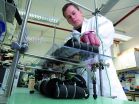(Press-News.org) ANN ARBOR, Mich. - Drugs aimed at quelling the behavior problems of dementia patients may also hasten their deaths more than previously realized, a new study finds.
The research adds more troubling evidence to the case against antipsychotic drugs as a treatment for the delusions, hallucinations, agitation and aggression that many people with Alzheimer's disease and other dementias experience.
In the new issue of the journal JAMA Psychiatry, researchers report findings from nearly 91,000 American veterans over the age of 65 with dementia.
Data from each patient who took a psychiatric medication was matched to data from a similar patient who didn't take drugs to calm behavior, by researchers from the University of Michigan Medical School and VA Center for Clinical Management Research.
Those taking drugs called antipsychotics had outsize risks of death. Among those taking the newer, more commonly used antipsychotics, the risk climbed along with the dose.
The study also examined other psychiatric medications. The risk of death seen with the mood stabilizer valproic acid was similar to the antipsychotics. Antidepressants had less risk compared with antipsychotics and valproic acid, but it was still higher than that of those not taking any psychiatric medications to treat behavior issues in dementia.
Antipsychotic drugs have significant risk of side effects, and the U.S. Food and Drug Administration warns that their use in people with dementia is associated with increased risk for cardiovascular adverse events and the risk of death.
"The harms associated with using these drugs in dementia patients are clear, yet clinicians continue to use them," says lead author and U-M/VA psychiatrist Donovan Maust, M.D., M.S. "That's likely because the symptoms are so distressing. These results should raise the threshold for prescribing further."
This new study and a recent state-of-the-art review by Maust's co-author Helen Kales, M.D., show that mortality risk of antipsychotics is higher, and benefit lower, than previously thought.
But the distress caused by uncontrolled symptoms probably explains why one-third of older adults with dementia who had long-term nursing home stays in 2012 were prescribed an antipsychotic medication, according to a recent U.S. Government Accountability Office report. About 14 percent of dementia patients in the community were prescribed an antipsychotic that same year, the GAO found.
Patients, families and their care teams deserve better to prevent and treat distressing dementia symptoms, Maust says.
The "DICE" approach to assess and manage behavioral symptoms in dementia that has been put forth by Kales and colleagues could help.
This approach emphasizes putting non-pharmacological strategies first. But the approach takes more time than writing a prescription, and its use will depend on the support of policy-makers and alignment of reimbursement strategies.
"In other words, non-pharmacologic approaches will only succeed if we as a society agree to pay front-line providers for the time needed to 'do the right thing'," says Kales.
Maust, Kales and their colleagues hope to continue studying the issue of mortality risk from the use of psychotropic drugs in dementia, and prescription patterns for these drugs, using other datasets.
INFORMATION:
In addition to Maust and Kales, the study's authors are Hyungjin Myra Kim, Sc.D., Lisa S. Seyfried, M.D., M.S., Claire Chiang, Ph.D., and Janet Kavanagh, M.S., all of U-M, and Lon Schneider, M.D., M.S. of the University of Southern California.
All the U-M authors except Kim are in the Medical School's Department of Psychiatry; Kim is in the Center for Statistical Consultation and Research. Maust, Kim, Chiang and Kales are member of the CCMR, and Maust and Kales are members of the U-M Institute for Healthcare Policy and Innovation.
The study was funded by the National Institute of Mental Health (MH08107) and the National Institute on Aging (AG048321). Both are part of the National Institutes of Health. The content is solely the responsibility of the authors and does not necessarily represent the official views of the National Institutes of Health.
More about the recent review article on behavior issues in dementia by Kales et al: http://umhealth.me/saynodice
More about the DICE approach: http://umhealth.me/DICEdem
Reference: JAMA Psychiatry. 2015;72(5):-. doi:10.1001/jamapsychiatry.2014.3018
TORONTO (March 18, 2015) - People with a severe form of schizophrenia have major differences in their brain networks compared to others with schizophrenia, bipolar disorder and healthy individuals, a new study from the Centre for Addiction and Mental Health (CAMH) shows.
The study, which used a novel approach to map brain networks, was led by researchers at the Campbell Family Mental Health Research Institute at CAMH and published in this week's JAMA Psychiatry.
"Finding ways to help this particular group of people with schizophrenia is a priority as recovery is ...
COLLEGE STATION - A ground-breaking Texas A&M AgriLife Research-led study on corn has identified useful gene variations for yield increases, drought tolerance and aflatoxin resistance that could make a real difference to Texas producers in the years to come, according to researchers.
The study, titled "Genome Wide Association Study for Drought, Aflatoxin Resistance, and Important Agronomic Traits of Maize Hybrids in the Sub-Tropics" was recently published in PLOS ONE, an international, peer-reviewed, open-access, online publication.
The study included the growing years ...
From computers, tablets, and smartphones to cars, homes, and public transportation, our world is more digitally connected every day. The technology required to support the exchange of massive quantities of data is critical. That's why scientists and engineers are intent on developing faster computing units capable of supporting much larger amounts of data transfer and data processing.
A new study published in Nature Photonics by Tel Aviv University researchers finds that new optical materials could serve as the nuts and bolts of future ultra-high-speed optical computing ...
TORONTO, March 18, 2015--Researchers have defined a new bodily process in mice that may explain why blood oxygen levels are lower for patients with cystic fibrosis when they get a lung infection.
"Infected areas of the lung are not as capable as healthy tissue at adding oxygen to the bloodstream, but no one has shown why this is the case," said Dr. Wolfgang Kuebler, a scientist in the Keenan Research Centre for Biomedical Science of St. Michael's Hospital. "We've shown that the protein produced by a gene known as CFTR is required to direct blood flow away from infected ...
This news release is available in Spanish. Using discarded electronic boards, the UPV/EHU researcher Andoni Salbidegoitia has, in collaboration with international researchers, developed a system for obtaining clean hydrogen that can be used as fuel. The researchers have already registered the patent of the process in Japan.
The Chemical Technologies for Environmental Sustainability (TQSA) Group of the Department of Chemical Engineering of the UPV/EHU's Faculty of Science and Technology is aiming to make use of discarded plastic as effectively as possible from the ...
Bats are not as stereotyped when they hunt as previously believed. New research shows that these flying mammals are capable of making ultra-fast decisions about how to attack their prey - or maybe even call off the attack. It takes only milliseconds.
Bats use echolocation for orientation. They emit ultrasonic sounds, which hit potential prey nearby, sending an echo back to the bat. From this echo the bat can define where the prey is and attack it. A new study has examined how hunting bats react when approaching their prey. The study concludes that bats are capable of ...
Imagine a loved relative suffering from cancer - and you could not afford a treatment because the drugs are too expensive. The Austrian Centre of Industrial Biotechnology (acib) developed a method with the power to reduce production costs of highly valued drugs significantly.
Without antibodies we would be at the mercy of pathogens or cancer cells. Therapeutic antibodies are used as passive vaccines, for cancer therapy or for controlling autoimmune diseases such as multiple sclerosis. According to "bccresearch.com" the global market for antibody drugs was worth nearly ...
Researchers have fine-tuned a technique for coating gold nanorods with silica shells, allowing engineers to create large quantities of the nanorods and giving them more control over the thickness of the shell. Gold nanorods are being investigated for use in a wide variety of biomedical applications, and this advance paves the way for more stable gold nanorods and for chemically functionalizing the surface of the shells.
Gold nanorods have a lot of potential applications, because they have a surface plasmon resonance - meaning they can absorb and scatter light. And by ...
This news release is available in Spanish. Alzheimer's disease is the most significant cause of dementia in the elderly: it affects over 35 million people worldwide. It is reckoned that Alzheimer's could reach epidemic proportions in developed countries unless therapies to cure or prevent it are obtained. Studies conducted so far reveal that the therapies are more effective when they are applied before the brain has become severely damaged. What is more, the spotting of early phases of the disease may help to develop new treatments. Right now, to make a clinical diagnosis ...
A new microarray-based tool, called VaginArray, offers the potential to provide a fast, reliable and low-cost assessment of vaginal health and diagnoses of infections. The research is published ahead of print March 2, in Antimicrobial Agents and Chemotherapy, a journal of the American Society for Microbiology.
The VaginArray has 17 probe sets, each one specific for one of the most representative bacterial species inhabiting the vaginal ecosystem, including those associated with both healthy and unhealthy conditions. Each probe set is designed to be complementary to the ...


